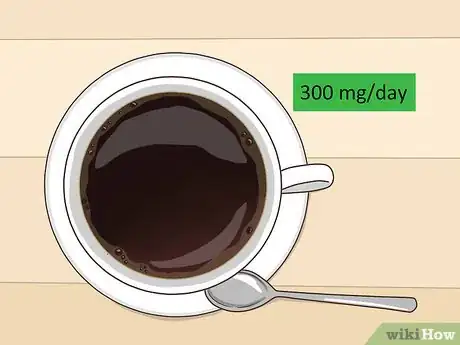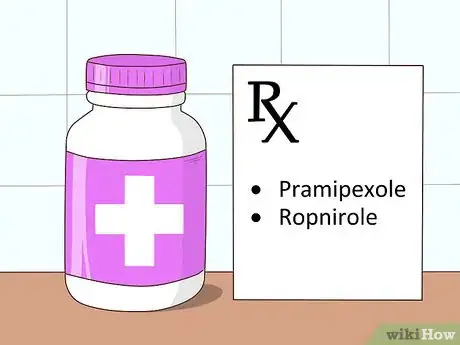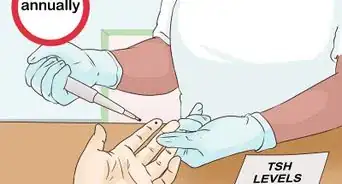This article was co-authored by Paul Chernyak, LPC. Paul Chernyak is a Licensed Professional Counselor in Chicago. He graduated from the American School of Professional Psychology in 2011.
There are 14 references cited in this article, which can be found at the bottom of the page.
wikiHow marks an article as reader-approved once it receives enough positive feedback. This article received 25 testimonials and 100% of readers who voted found it helpful, earning it our reader-approved status.
This article has been viewed 1,659,069 times.
The dopamine produced by your brain naturally makes you feel good, as your brain sees its release as a reward. For instance, you get a rush of dopamine in response to pleasurable activities like eating or having sex.[1] You can make sure you're getting enough dopamine by looking at your diet and lifestyle, though medications can also make a difference in your dopamine levels. If you're worried about your levels, always talk to a doctor for advice.
Steps
Increasing Dopamine through Diet
-
1Eat foods rich in tyrosine. In order to make dopamine, your body needs tyrosine, which is an amino acid. When it enters your body, the amino acid travels to your brain. Once there, the neurons responsible for releasing dopamine transform it into dopamine with the help of other enzymes.[2]
- The foods highest in tyrosine include cheese, fish, meat, seeds, grains, dairy, beans, and soy.
- As long as you're getting enough protein in your diet, you should be getting enough tyrosine. To determine how much protein you need, multiple your weight in pounds by 0.36 grams. For instance, if you weigh 150 pounds (68 kg), you need 54 grams of protein.
- As an example, 0.5 cups (120 mL) of cottage cheese has 14 grams of protein, while a serving of chicken the size of your palm has about 19 grams of protein.[3]
-
2Consume protein-rich foods to get your daily dose of phenylalanine. Tyrosine can be produced in part from phenylalanine, so eating foods rich in this amino acid can ensure you're getting enough tyrosine. In turn, that may increase dopamine. Meats, cheeses, and wheat germ are rich in this food. Artificial sweeteners also contain this amino acid.[4]
- You should consume at least 5 grams of phenylalanine a day, but you can eat up to 8 grams per day. As an example, 3 ounces (85 g) of many cheeses have about 1 gram of phenylalanine in them.
Advertisement -
3Get your daily jolt of caffeine. Caffeine is one of the main ways to increase the body's use of dopamine. While it doesn't increase your production of dopamine, it likely works by making more receptors available to use the dopamine your body produces.[5]
- Try taking or drinking up to 300 milligrams per day. An average cup of coffee has about 100 milligrams.
- Keep in mind that caffeine can cause depression and fatigue once it's out of your system, which usually occurs about 6 hours after you consume it. Try not to rely too much on a caffeine boost.[6]
- Also remember that caffeine can prevent you from falling asleep, so avoid drinking it 6 hours before bed.
Making Lifestyle Changes
-
1Set goals and reward yourself for achieving them. When you are approaching a reward, such as the achievement of a goal, your body releases dopamine. Once you set a goal, plan out small, concrete steps you can take. Each time you achieve a part of your goal by taking a step, your brain may reward you with dopamine.[7]
- For example, say your goal is you want to learn how to paint. You could set small goals like get supplies, set up a workstation, and practice painting 30 minutes every day.
-
2Spend more time in sunlight to increase your dopamine sensitivity. Sunlight likely plays a role in how many dopamine receptors are available to "catch" the dopamine. In other words, while it doesn't increase dopamine per se, it increases the amount your system is making use of, offering similar benefits.[8]
- Spending as little as 5 to 10 minutes in the sun can help. Try taking a walk at your lunch break to get a little sunshine in.
-
3Practice meditation when you want to release dopamine. True meditation relaxes you completely, to the point that you have less of a desire to act. In turn, your body may release dopamine in response, as a way of encouraging action. Try practicing meditation 2-3 times a day.[9]
- Even simple meditation like deep breathing can increase your dopamine levels. For deep breathing, try focusing on just your breathing. Breathe in to the count of 4, and then hold for 4 counts. Breathe out to the count 4. Repeat this action, focusing solely on your breathing.
- You can try a meditation app such as Insight Timer, Calm, or Headspace. You can follow either a guided or non-guided meditation.
-
4Practice gratitude and thankfulness. Gratitude is linked to the release of dopamine in your brain. The more thankful you are, the more likely your brain is to release dopamine. Just being thankful for a good meal or something a friend just did and expressing it is a way to release dopamine.[10]
- You can also try keeping a gratitude journal, where you write down 5 things you're thankful for each day.
Using Medications and Supplements
-
1Take levodopa to increase dopamine in the brain. Levodopa is a precursor of dopamine, meaning it can be transformed into dopamine in the brain. Taking levodopa increases the amount of dopamine your body produces.[11]
- You may be prescribed this medication by your doctor if you have a disease like Parkinson's or restless leg syndrome.
- Side effects include nausea, vomiting, dry mouth, impairment of voluntary movement, and dizziness. It can also cause hallucinations and confusion in some people.
-
2Discuss a dopamine agonist to increase dopamine receptors. While levodopa increases the amount of dopamine your body makes, dopamine agonists actually up the number of receptors to "catch" the dopamine. You can take this medication in place of or in addition to levodopa.[12]
- The 2 most commonly prescribed dopamine agonists are pramipexole and ropinirole.
- The main side effect of these medications is daytime sleepiness, which may even cause you to fall asleep against your will.
- This medication is also used for diseases like Parkinson's and restless leg syndrome.
-
3Try velvet bean as a supplement. The velvet bean naturally contains levodopa. Like stronger prescription medications, that means it may increase dopamine in your brain. Look for a supplement that contains extract of Mucuna pruriens with 15% L-dopa or levodopa. Take 300 milligrams 2 times a day of this extract.[13]
- Always talk to your doctor before beginning any supplement, especially one so similar to a prescription medication.
-
4Consider golden root as a supplement. Golden root, also known as Rhodiola rosea, may increase dopamine activity in the brain. Try starting on 200 mg of a supplement with Rhodiola rosea extract. Look for one that has 2-3% rosavin and 0.8-1% salidroside. Take this supplement once a day. You can take as much as 600 milligrams in one day.
- Talk to your doctor before starting this supplement.
- Take it 30 minutes before you eat early in the day. It can cause insomnia if you take it too late in the day.
Expert Q&A
Did you know you can get expert answers for this article?
Unlock expert answers by supporting wikiHow
-
QuestionHow long will it take to increase the level of dopamine if I exercise and eat a good diet?
 Paul Chernyak, LPCPaul Chernyak is a Licensed Professional Counselor in Chicago. He graduated from the American School of Professional Psychology in 2011.
Paul Chernyak, LPCPaul Chernyak is a Licensed Professional Counselor in Chicago. He graduated from the American School of Professional Psychology in 2011.
Licensed Professional Counselor
-
QuestionHow to replace the dopamine which is released from masturbation?
 Paul Chernyak, LPCPaul Chernyak is a Licensed Professional Counselor in Chicago. He graduated from the American School of Professional Psychology in 2011.
Paul Chernyak, LPCPaul Chernyak is a Licensed Professional Counselor in Chicago. He graduated from the American School of Professional Psychology in 2011.
Licensed Professional Counselor
References
- ↑ http://www.news-medical.net/health/Dopamine-Functions.aspx
- ↑ https://www.macalester.edu/projects/UBNRP/meth08/biochemistry/dopamine.htm
- ↑ https://www.health.harvard.edu/blog/how-much-protein-do-you-need-every-day-201506188096
- ↑ https://pubchem.ncbi.nlm.nih.gov/compound/L-phenylalanine#section=Top
- ↑ https://www.ncbi.nlm.nih.gov/pmc/articles/PMC4462609/
- ↑ https://medlineplus.gov/caffeine.html
- ↑ https://www.psychologytoday.com/us/blog/your-neurochemical-self/201212/five-ways-boost-your-natural-happy-chemicals
- ↑ https://www.ncbi.nlm.nih.gov/pubmed/20875835
- ↑ https://pubchem.ncbi.nlm.nih.gov/compound/L-phenylalanine#section=Top
- ↑ https://www.psychologytoday.com/us/blog/prefrontal-nudity/201211/the-grateful-brain
- ↑ https://www.ncbi.nlm.nih.gov/books/NBK482140/
- ↑ https://www.parkinson.org/Understanding-Parkinsons/Treatment/Prescription-Medications/Dopamine-Agonists
- ↑ https://www.ncbi.nlm.nih.gov/pmc/articles/PMC3942911/
- ↑ https://universityhealthnews.com/daily/depression/7-serotonin-deficiency-symptoms-that-you-can-identify-yourself/
About This Article
If you’re trying to increase your dopamine levels, make sure to eat foods that are rich in amino acids, like meat, dairy, and beans, to help your body produce more dopamine. Additionally, try having a cup of coffee and spending a few minutes in the sun every day to increase your body’s use of dopamine. You may also want to try meditation or deep breathing exercises, which have been shown to increase dopamine levels. For example, practice breathing in deeply, holding the breath for a few seconds, then slowly exhaling while focusing solely on your breathing. To learn how to set and meet personal goals to help increase your dopamine levels, keep reading!










































































Medical Disclaimer
The content of this article is not intended to be a substitute for professional medical advice, examination, diagnosis, or treatment. You should always contact your doctor or other qualified healthcare professional before starting, changing, or stopping any kind of health treatment.
Read More...